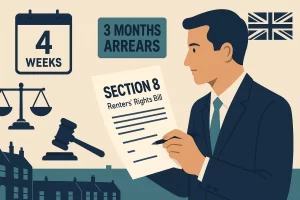November has been a big month for landlords in England. The Renters’ Rights Act 2025 is now law, with the government finally publishing a detailed implementation roadmap, and the Autumn Budget 2025 has confirmed higher taxes on rental income and expensive homes.
If you let property in England, the next 18–24 months will reshape both how you manage tenancies and what you take home after tax.
1. Renters’ Rights Act 2025 – where things stand now
1.1 Key dates at a glance
- 27 October 2025 – Renters’ Rights Bill receives Royal Assent and becomes the Renters’ Rights Act 2025.
- 27 December 2025 – First wave: strengthened investigatory powers for local authorities and higher possible civil penalties.
- 1 May 2026 – “Big bang” Commencement Date for the private rented sector in England:
- Section 21 ‘no-fault’ evictions abolished for PRS tenancies
- New Assured Periodic Tenancy system starts
- Rent increases capped to once per year via revised section 13 procedure
- Ban on rental bidding and limits on rent in advance
- New statutory rules on discrimination, pets and enforcement.
- By 31 May 2026 – Landlords with existing tenancies must give tenants the official Information Sheet explaining the changes.
- From late 2026 – Phased rollout of the PRS Database and PRS Landlord Ombudsman, becoming mandatory from 2028.
2. Section 21 is going – what that actually means in practice
2.1 When does section 21 end?
Under the government’s roadmap, section 21 ‘no-fault’ evictions are abolished in the PRS from 1 May 2026. From that date, landlords will no longer be able to use section 21 to recover possession; you will need to rely on section 8 grounds instead.
Specialist landlord guidance and transitional commentary confirm two practical cut-offs:
- Last realistic day to serve section 21:
- Thursday 30 April 2026 – identified as the last date a valid section 21 notice can be served under the transitional rules.
- Deadline to issue court proceedings on an existing section 21 notice:
- Court claims based on a valid section 21 notice must be issued by 31 July 2026.
After that, section 21 falls away for practical purposes and section 8 becomes your route to possession.
Action point: If you are considering using section 21 at all, you should review your portfolio and take advice well before 30 April 2026 so you have time to serve notices and issue any necessary claims by the 31 July 2026 deadline.
3. The new tenancy system from 1 May 2026
From 1 May 2026, the Act moves almost all private lettings in England onto a single, open-ended tenancy model.
3.1 Assured Periodic Tenancies replace fixed-term ASTs
- No more new fixed-term ASTs in the PRS.
- Existing assured shorthold tenancies will convert into Assured Periodic Tenancies (APTs).
- The tenancy continues indefinitely until:
- The tenant ends it with at least 2 months’ notice, or
- The landlord proves a valid section 8 ground (for example, sale, moving back in, serious rent arrears or anti-social behaviour).
Tenants gain long-term security, but landlords still keep ground-based routes to possession.
3.2 Updated section 8 grounds – especially for serious arrears
You will still be able to seek possession under section 8, but:
- The Act revises the grounds, with:
- Clearer routes for anti-social behaviour, and
- A higher threshold for the main mandatory “serious rent arrears” ground (Ground 8), generally moving from 2 months to 3 months’ rent arrears where rent is paid monthly, with a longer notice period.
The detail sits in schedules to the Act and secondary legislation, but the direction of travel is clear: courts will expect better evidence and compliance, and “serious” arrears will mean more arrears than before.
4. Rent increases, bidding wars and rent in advance
4.1 One rent increase per year, via section 13
From 1 May 2026, the Act brings in a stricter rent-increase regime:
- Only one rent increase every 12 months for PRS tenancies.
- Rent must be increased via the revised section 13 procedure, using a prescribed form (a new Form 4A) and giving at least 2 months’ notice.
- Tenants can challenge the proposed rent at the First-tier Tribunal, which will assess whether it reflects market rent, and can adjust or delay the increase.
You therefore need a clear rent review strategy and evidence of market comparables before serving notices.
4.2 Ban on rental bidding wars
From the same date, rental bidding wars are banned:
- You must advertise a single rent.
- Landlords and agents cannot ask for, encourage or accept offers above the advertised rent.
This effectively outlaws the “best and final offers above asking” approach that has become common in tight rental markets.
4.3 Rent in advance capped
The Act also tackles rent in advance:
- You cannot require more than one month’s rent in advance for a new tenancy.
- You also cannot take rent before both parties have signed the tenancy agreement, and clauses demanding rent before the tenancy officially begins or for more than one month up front will be unenforceable.
Landlords who’ve relied on six or twelve months’ rent up front (for example, with students or higher-risk tenants) will need to rethink their approach.
5. Discrimination, pets and enforcement – new compliance risks
5.1 “No DSS / no kids” policies banned
From 1 May 2026, the Act explicitly prohibits discrimination in the PRS against:
- Tenants with children under 18, and
- Tenants in receipt of benefits.
Banned behaviour includes:
- Advertising properties with “no benefits” or “no children”
- Refusing viewings on that basis
- Refusing to grant a tenancy once benefits or children are disclosed
Local authorities will be able to investigate and issue civil penalties, which can escalate for repeat offences.
5.2 Right to request a pet
Tenants will have a statutory right to request a pet, and:
- Landlords must consider the request within 28 days, and
- Give a valid reason if refusing.
You can still rely on superior lease restrictions (for example, if a headlease bans pets), but you’ll need a clear paper trail.
5.3 Stronger enforcement, database and Ombudsman
The Act significantly ups the compliance stakes:
- From 27 December 2025, councils get stronger investigatory powers to inspect properties, demand documents and access third-party data.
- From 1 May 2026, civil penalties and rent repayment orders are expanded and maximum fines for certain housing offences increase (for some offences from £30,000 to £40,000).
- From late 2026, the PRS Database begins rolling out, with:
- Mandatory registration for all PRS landlords
- An annual fee (to be set nearer launch)
- Requirements to record landlord details, property details and key safety information.
- By 2028, membership of a PRS Landlord Ombudsman scheme is expected to be compulsory, giving tenants a quicker, out-of-court route for complaints, backed by binding decisions.
Phase 3, which will extend Awaab’s Law and a private-rented Decent Homes Standard, is planned but timing is still “to be confirmed” – it is flagged in the roadmap, but not tied to a specific year.
6. Autumn Budget 2025 – tax changes landlords need to know about
On 26 November 2025, the Chancellor delivered an Autumn Budget that raises taxes on rental profits and expensive homes, and tweaks the savings landscape.
6.1 2-point hike on property income from April 2027
The big headline for landlords:
- Tax on property income (including most rental profits) rises by 2 percentage points from April 2027.
New rates on rental profits (after allowable expenses and finance cost rules) will be:
- 22% for basic rate taxpayers
- 42% for higher-rate taxpayers
- 47% for additional-rate taxpayers
These changes do not alter the main income tax bands on salary (20%, 40%, 45%); they apply specifically to property, savings and dividends, which are not subject to National Insurance.
6.2 Thresholds frozen to 2031 – fiscal drag
The Budget also extends the freeze on key income tax and National Insurance thresholds until April 2031, pulling more people into higher tax bands over time.
For landlords, the combination of:
- A 2-point rate rise on rental profits, and
- Frozen thresholds
means your effective tax bill can rise even if your nominal income barely changes.
6.3 New annual tax on high-value homes from April 2028
From April 2028, the government will introduce a new annual tax on homes worth over £2 million, on top of normal council tax.
Key points:
- Applies to properties valued above £2m (based on 2026 Valuation Office Agency values, uprated annually with CPI).
- Four bands, with the surcharge starting at £2,500 per year and rising up to £7,500 per year for homes worth £5m or more.
- Treasury estimates suggest this will hit a relatively small slice of the market, but it is very relevant for prime London and high-value rental stock.
If you let out high-value properties, you should factor this recurring annual charge into your medium-term yield calculations.
6.4 ISA changes from April 2027
The Budget also reshapes ISA allowances:
- From 6 April 2027, the cash ISA limit falls to £12,000 for most savers (a 40% cut from £20,000).
- The overall ISA limit stays at £20,000, so the remaining £8,000 can still go into stocks and shares ISAs.
- Over-65s keep the £20,000 cash ISA allowance.
For landlords who park cash in ISAs between purchases or refurbishments, this may change how you structure savings and investments.
6.5 What didn’t happen: no National Insurance on rental income (for now)
For months, there were leaks and think-pieces suggesting the Budget would extend National Insurance to rental income, with some reports even modelling an 8% NI charge on landlords’ net rents.
In the end, the Chancellor chose a different route:
- She did not introduce NI on rental income.
- Instead, she raised tax rates on property, savings and dividends by 2 percentage points, while reiterating earlier promises not to increase NI rates themselves.
The political and policy logic behind taxing “asset income” more heavily is now on record, though – so National Insurance on rents remains a live idea for future budgets, even if it was not used this time.
7. What landlords should do next (December 2025 – early 2026)
To stay ahead of both the Renters’ Rights Act and the Autumn Budget changes, landlords should be using the next few months to plan.
7.1 Review your portfolio for section 21 decisions
- Identify any tenancies where you may want to regain possession using section 21 under the current regime.
- Work backwards from 30 April 2026 (last realistic date to serve) and 31 July 2026 (deadline to issue claims) to set internal timelines.
If you do need to act, early, compliant notices and well-prepared claims will be critical to avoid missing the transitional window.
7.2 Update your tenancy strategy for May 2026
- Move to Assured Periodic Tenancy templates for new lets.
- Build a clear section 8 strategy, including how you’ll evidence serious rent arrears and anti-social behaviour.
- Decide your rent review policy under the one-increase-per-year rule and get ready to use the new section 13 form.
7.3 Get compliant on discrimination, pets and upfront rent
- Strip out any “no DSS”, “no benefits”, “professionals only” or “no children” language from adverts and internal criteria that could amount to unlawful discrimination.
- Adopt a standard process for pet requests with clear reasons for consenting or refusing.
- Review your approach to rent in advance so you are not requesting more than one month up front or taking rent before the agreement is signed.
7.4 Plan for tax and cash-flow changes
- Ask your accountant to model:
- The 2-point rise in property income tax from April 2027, and
- The impact of frozen thresholds to 2031
on your projected net yields.
- If you hold or plan to buy property worth over £2m, factor in the new annual surcharge from April 2028.
- Revisit where you hold cash and investments in light of the reduced cash ISA allowance from April 2027.
8. Final thoughts
November 2025 has “locked in” two major trends for landlords in England:
- Regulation is tightening – with the Renters’ Rights Act 2025 moving the sector to open-ended tenancies, banning section 21, restricting rent increases and clamping down on discrimination, bidding wars and rent in advance.
- The tax take is rising – via higher rates on rental profits, frozen thresholds and a new annual charge on high-value homes, rather than (for now) through National Insurance on rents.
Landlords who engage early, update their documents and processes, and plan for the combined impact of legal and tax changes will be best placed to protect their position and keep their portfolios profitable.


